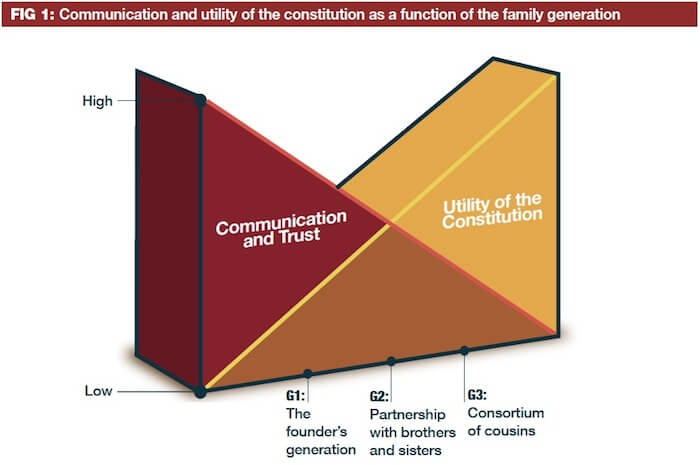Family harmony is a key ingredient in bringing about continuity in the family business. To preserve such harmony and good communication the business family is advised to start building a family constitution. Dr. Brahim Allali, Professor at HEC Montreal and Business Family Coach, explains how the degree of communication and the utility of a family constitution are a function of the family generation in charge and describes in a case study how a business family may come to surprising results when embarking on writing a constitution.
[ms-protect-content id=”4069,4129″]
Why harmony and communication matter
Analysis of breakdowns in business families reveals that the main cause for their demise is an absence of or deficit in communication within the families. In a business family, we presume, often wrongly, that the designated successor will agree to take over the business, even though this may not be the case; we presume that family members concur about the manner in which the manager runs the family business; we presume that the whole family agrees on fundamental values and the code of conduct that each member should respect; we presume that everyone wants to keep the business in the family. In fact we tend to make many presumptions some more founded than others.
In the article “Getting your Brain in Gear – Communication in Family Businesses” published in volume 17 of Tharawat magazine, author Ian Marsh writes: “Most families become aware of a lack of communication when its effects are felt in relations between family members, and that realisation itself often makes the miscommunication worse.” While recognising the accuracy of this declaration it should, however, be qualified within the socio-cultural context of the business families. In Arab business families for example, while as a general rule very respectful towards elders, the younger members of the families, rather than entering into direct conflict with their parents, prefer more and more often to pursue independent careers outside of the family business. In this way the conflicts only become apparent much later; sometimes much too late and only when the time has come to hand over the business and it becomes clear that nobody is interested any longer in taking over the family company.
On the other hand, analysis of successful business families unequivocally shows that maintaining harmonious relations between the family members through frank, intense and free-flowing communication is favourable to success and longevity. Yet, the more we move forward through the generations, the more family members increase in number and the more difficult direct communication between all members becomes. When the lines of communication slacken, trust between family members tends to weaken. For example, how is it possible to bring together 60 or more cousins who are dispersed geographically all over the planet, to discuss and come to agreement about questions concerning the management and development of the family business?
The role of the family constitution
The family constitution holds a crucial role in answering the above question: In very simple terms the family constitution, also known as family protocol and family charter, is to the business family and its governing bodies what the national constitution is to the parliament and the government of a country. It clearly sets out the mission of the business family, its vision, its fundamental values, its code of conduct, the criteria relative to membership of the family and other such factors. It also defines the family’s governing bodies, such as the Family Assembly, the Family Council, or the Family Executive Board. It describes the organisation and its ways of operating. Rules to prevent conflicts between members of the business family and how to resolve them if they do appear are also set out. In this way we can find, for example, the conditions that govern a member of the family working for the family business, as well as his or her compensation. We also find the conditions for family representation on the Board of Directors and other bodies.
As the dispositions of the charter are set out in an impersonal manner in conformity with the rules for procedural justice, they are applied equally and equitably to all members of the family without favouritism or discrimination. In this way conflicts between the members of the family are reduced to a minimum and the people who are supposed to represent the interests of all are elected in a transparent way, in conformity with the dispositions of the constitution. Therefore, there is no need for all of the family members to know each other, to spend time together or to express mutual confidence in each other in order for harmony to reign within the family.
Ideally, the family constitution should be written while the first generation is in charge, even if communication and trust are still strong between the members of the family at the time and the need to prepare for conflict is not yet a matter of any urgency. It should be revised each time that a new situation appears that calls for an existing disposition to be modified or a new one added. In fact, experience shows that there is considerable difficulty when drafting a new constitution after the first generation, when trust begins to erode between members of the family. Paradoxically, it is at this time that the need is greatest to have a constitution that would prevent the conflict occasioned by the communication deficit and the build-up of mistrust in relations (Figure 1).
Case study of a family building a constitution
In April 2012, a fourth generation member of a powerful business family from Casablanca, asked a professional advisor to lead a training workshop to leverage on family harmony and its benefits for the family members. While preparing the said workshop, the advisor was surprised to learn that there was no conflict between the members of the family in question. However, during the workshop process in which members of the last three generations participated, using televoting that allowed them to answer certain questions anonymously, everybody was disconcerted to discover that family members were unable to agree on such fundamental questions as the family’s values and its priorities. Neither did they agree on the criteria for defining membership of the family.
At the end of the workshop, the family members mandated the advisor to assist them in writing a family constitution. He discovered that the reason that there were no conflicts between the family members was because those members, exasperated by the methods of the current manager, had abandoned the family business to pursue individual careers. It was not easy to write a new constitution for this family as the difference in points of view and the mistrust between its members were considerable. However, once written and approved after intensive and repetitive work not dissimilar to the waggle dance of bees, harmony was restored within the family. Several of the members announced their intention to return to the family business and the manager, who had come to understand that the time to step down had arrived said: “I now realise that we should have equipped ourselves with a family constitution more than 25 years ago, but better late than never.”
Tharawat Magazine, Issue 18, 2013
[/ms-protect-content]















